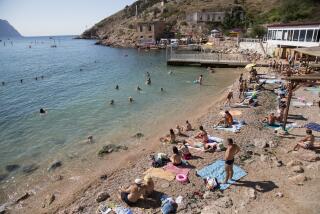Environment : Icy Debate Over Bering Strait : * Naturalists and oil companies are squaring off over a plan to create a U.S.-Russian park that includes Eskimo habitat.
- Share via
MOSCOW — A proposed Russian-American international park straddling the Bering Strait and preserving the original Eskimo habitat has become the battleground in a new struggle over whether to develop or protect fragile northern environments.
On one side of the fight are American naturalists and Russian environmentalists in an unprecedented alliance; on the other are U.S. oil companies and local officials wanting to develop Russia’s Chukotski Peninsula across the Bering Strait from Alaska.
A treaty establishing the park was signed by President Bush and former Soviet President Mikhail S. Gorbachev at their summit meeting in June, 1990. But opposition to it has grown in Chukotka, a Russian district that includes the peninsula. Oil and gas deposits are seen as keys to the region’s economic development.
“The local budget in Chukotka is full of holes,” Fedor F. Ivanov, a member of the environment committee of the Russian Supreme Soviet, the national legislature, said. “Their only hope at the moment is revenue from the oil and gas operations on and around the peninsula.”
Officials at the Russian Oil and Energy Ministry are close-mouthed about the size of the suspected oil and gas deposits, and Ivanov said the matter “is very sensitive at the moment especially since the negotiations are under way. I can tell you, though, that the talk is about a very juicy portion.”
Nevertheless, Ivanov said he thinks the problem “can be resolved through talks between the interested parties and judicious zoning of the area. Some economic activity must be allowed within the park’s limits.”
With such a compromise, Ivanov said he thinks the project would proceed. “The Supreme Soviet regards this project as a political obligation Russia inherited from the former Soviet Union,” he said. “We will never renege on it, and we will make every effort that the park is established by the end of 1992, as the agreement between the two presidents envisages, and within the designated borders.”
But the persistent lack of progress brought a group of American naturalists, including Peter A. Berle, president of the National Audubon Society, to Moscow earlier this month to help Russian environmentalists lobby lawmakers here.
“We have already committed 3 million acres in Alaska, and we have carried out much preparatory work,” Berle said. “Now, we want to know what is holding up the plan out there in Chukotka. We definitely expect the Russians at least to designate the land on their side.”
Environmentalists in the United States and Russia view the territory to be included in the Beringian Heritage International Park as unique, with its combination of biological, cultural and archeological treasures, all of which are highly vulnerable to economic development and other pressures of modern times.
The U.S. part of the proposed park, already committed, is the Bering Land Bridge National Preserve in Alaska, totaling 2.7 million acres. The Russian share, still only pledged, is supposed to be 9.1 million acres, or practically the entire territory of the Chukotski Peninsula, plus the surrounding marine area.
The environmentalists argue that the historical sites and artifacts of the 2,000-year-old Eskimo culture, which developed in the park area in harmonious cohabitation with some of the world’s rarest birds and animals, require quick action if they are to be saved from advancing economic development.
But the proposed park area on the Russian side, with the adjoining 60 miles of coastal waters to protect valuable fish and mammals, includes the potentially oil-rich territory that U.S. companies, including Hunt Oil Co., are interested in exploring.
The visit of the U.S. environmentalists focused renewed attention here on the proposed park. The Supreme Soviet’s environmental committee invited the Americans to testify at a special legislative hearing on the Chukotka portion of the park this month--along with other officials ranging from border guards to water chemists. “Our testimony caused a lot of interest,” Berle said, “and we were able to provide the expertise they needed for considering the issue.”
In an interview, Berle suggested that a reasonable compromise between economy and ecology is possible. But the Russian lawmakers complain that most resistance now comes from the Chukotka region itself; authorities there are talking to U.S. oil companies about the royalties they would receive if the drilling rights are granted.
“The Chukotka administration people are spreading rumors among the native population . . . that if the park is established, no more walrus or seal hunting will be allowed,” Ivanov complained. He also expressed fears that the U.S. oil companies, if granted the drilling rights, might abuse the fragile ecosystems in the area, whether or not a park is established. “We have reasons to believe that the U.S. companies, if they begin their drilling, would employ obsolete--and thus harmful--technology because this is much cheaper,” Ivanov said.
“And our officials, regrettably, are easily bought off, especially now. So there will be no effective control until it is too late to exercise it.”
Vladimir A. Santalov, a prominent Chukotka-area ecologist, also concedes that certain “economic activities” must be allowed within the borders of the international park, at least on the Russian side. But “development within limits” may not be enough to satisfy the local authorities.
American supporters of the Beringian Heritage International Park say tourism is the best alternative source of revenue once the park is established and begins to operate but that it holds little promise for the Russian side.
“The plan envisages 12,000 tourists a year and that’s against the 20,000 population within the park limits,” Santalov said, shrugging off the proposal. “You’ve got to spend billions (of rubles) before the adequate infrastructure and services are put into place. Where is the money coming from?”
But dwindling oil production in the traditional oil fields may yet swing the scales in favor of the Chukotka oil deal--and away from the fate of more than 140 bird species, 25 of which are regarded as endangered. The U.S. part of the park on the Seward Peninsula will not, by itself, be enough to save the birds and the marine mammals, which provide a significant part of the local Eskimo diet.
The big hope for Russian environmentalists is President Boris N. Yeltsin’s desire to improve relations with the West, which they think may yet save the beleaguered project.
“Throwing his (Yeltsin’s) weight behind the national park plan will be a low-cost way for him to protect a joint Russian-American interest and to send the fast-greening world a signal that he cares,” Berle said.
More to Read
Sign up for Essential California
The most important California stories and recommendations in your inbox every morning.
You may occasionally receive promotional content from the Los Angeles Times.













